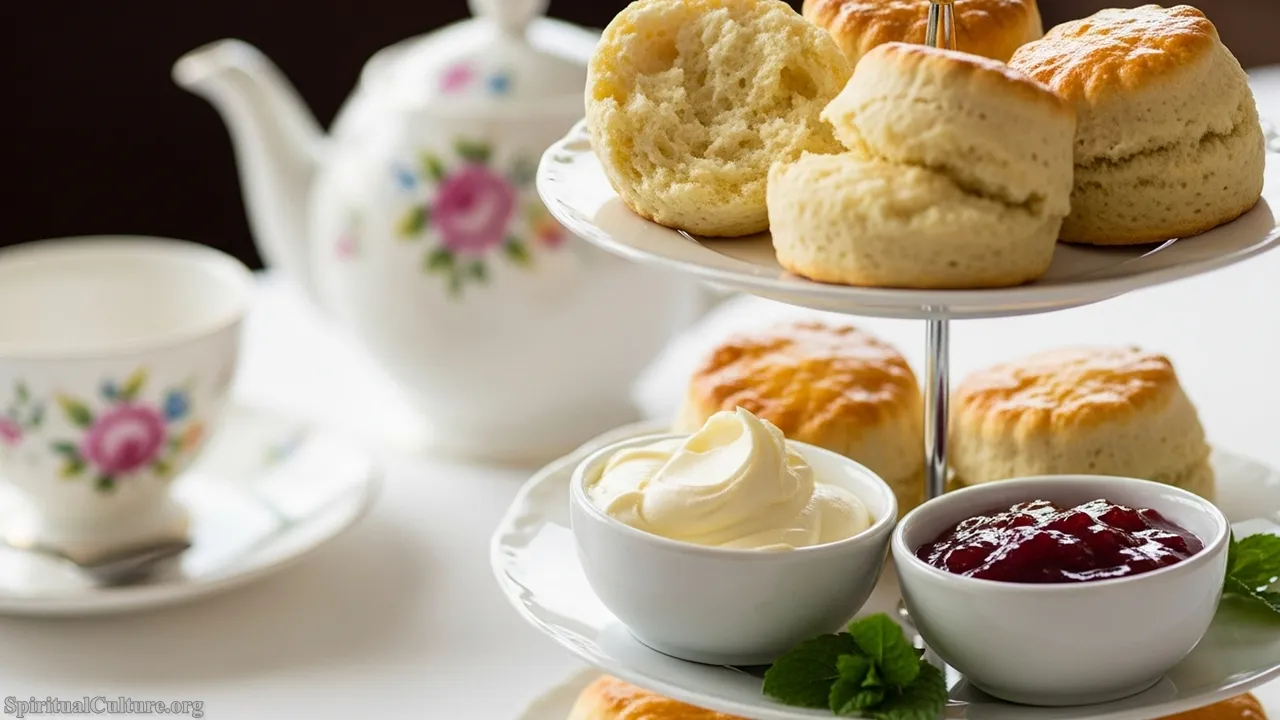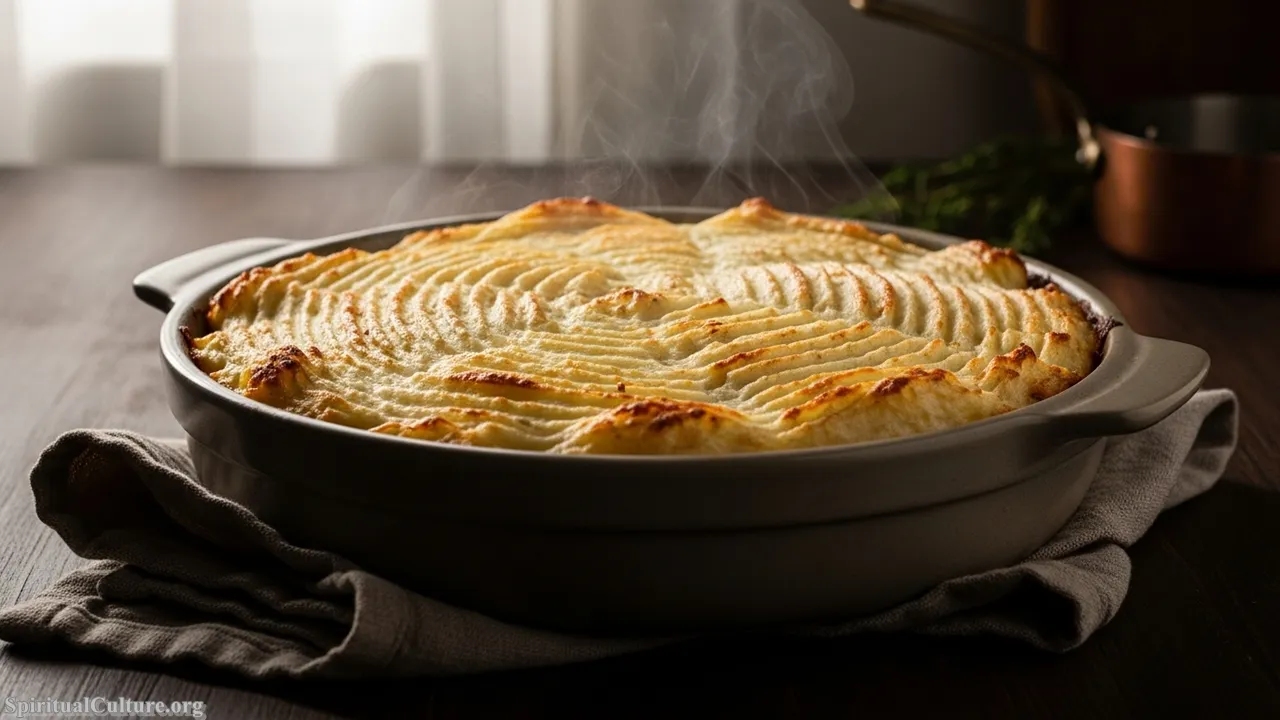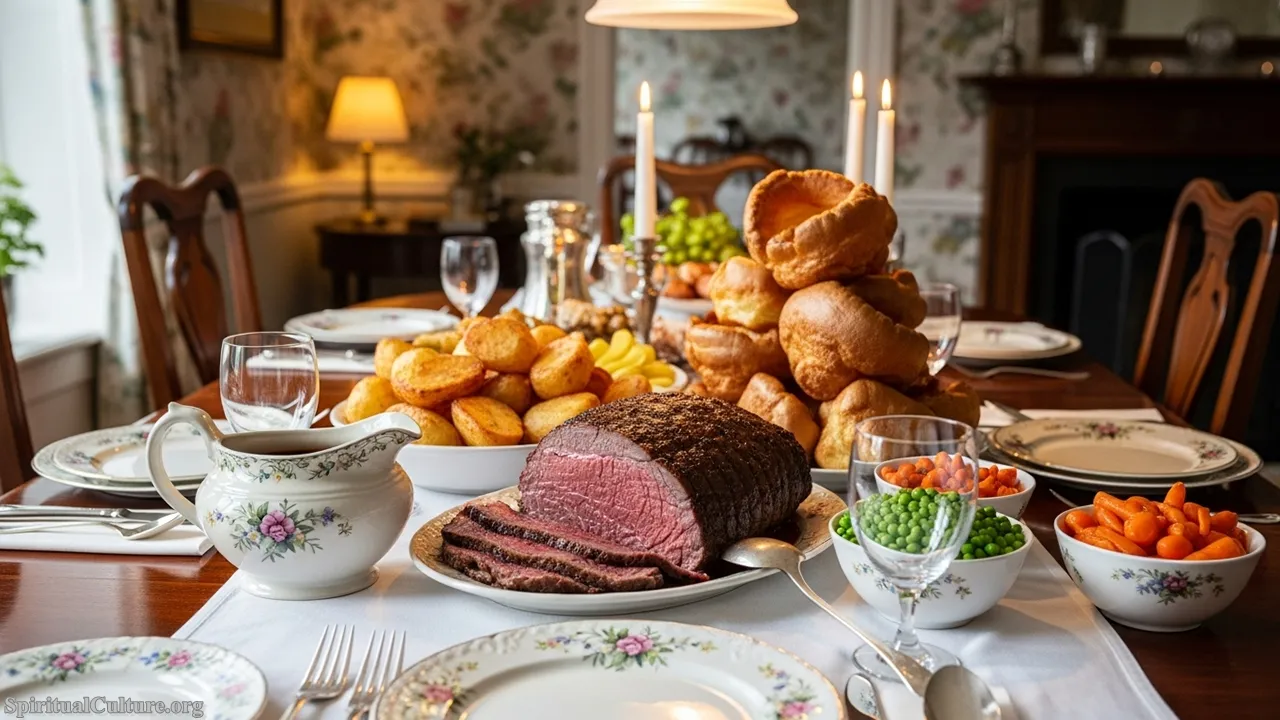The cuisine of the United Kingdom, often misunderstood globally, is a profound reflection of its island history—a tapestry woven from necessity, innovation, colonialism, and a deep-seated love for hearth and home. These dishes, forged by the Industrial Revolution’s need for fast fuel, the agricultural calendar’s rhythm, and the warmth of pub culture, are far more than mere calories; they are cultural anchors.
At Spiritual Culture, we view British food through the lens of heritage. The true “popularity” of a dish is measured not just by sales figures at the Current Time of Writing, but by its persistence as a national ritual—from the weekly family Sunday lunch to the essential comfort of ‘pub grub.’ These Top 10 selections embody Britain’s culinary soul, showcasing resilience and community spirit in every bite.
This authoritative list moves beyond simple taste, celebrating the historical, emotional, and collective significance of the meals that define British life. We analyze which traditional foods continue to dominate family tables, pub menus, and takeaway queues, proving their enduring cultural value in the modern era.
Table of the Top 10 Most Popular Traditional British Foods by Cultural Impact and Consumption Frequency
| Rank | Traditional Food | Primary Cultural Context | Spiritual/Heritage Value |
|---|---|---|---|
| 1 | Fish and Chips | Seaside/Takeaway Culture, Industrial Working Class Staple | Unity, Accessible Comfort, National Identity Symbol |
| 2 | Sunday Roast | Weekly Family Gathering Ritual | Communal Blessing, Family Tradition, Hearth & Home Focus |
| 3 | Full English Breakfast | Weekend Ritual, All-Day “Fry-Up” (Sustenance) | Preparative Energy, Celebration of Local Produce, Hospitality |
| 4 | Bangers and Mash | Classic Pub Grub/Comfort Food | Simplicity, Post-War Resilience, Unpretentious Warmth |
| 5 | Shepherd’s/Cottage Pie | Homestyle Supper, Resourcefulness (Leftovers) | Nourishment, Thrift, Rural Heritage (Lamb/Beef) |
| 6 | Steak and Kidney Pie | Hearty Pub Meal, Historical Traveling Food | Endurance, Deep Culinary Roots, Winter Comfort |
| 7 | Yorkshire Pudding | Essential Roast Dinner Accompaniment | Symbol of Anticipation, Regional Pride (The North) |
| 8 | Cornish Pasty | Portable Lunch, Miner’s Heritage (Cornwall) | Practicality, Working-Class History, Regional Identity |
| 9 | Sticky Toffee Pudding | Post-Dinner Dessert Staple | Indulgence, Modern Tradition, Comforting Sweetness |
| 10 | Afternoon Tea (Scones) | Mid-Afternoon Social Ritual | Elegance, Social Etiquette, Moment of Quiet Reflection |
#10. Afternoon Tea (Scones with Jam and Clotted Cream)
Though often associated with high society, the practice of taking a “low tea” or a simple cream tea is an enduring tradition that makes Scones with Clotted Cream and Jam one of the nation’s most recognizable and cherished foods. As of the Current Time of Writing, the debate over whether the jam or the cream should be applied first remains a spiritual battleground between Devon and Cornwall, but the ritual itself is a constant, universally celebrated moment of civilized pause.

The spiritual impact of Afternoon Tea lies in its dedication to social etiquette and reflective slowing down. It is a secular ceremony, a time deliberately carved out of the day to converse, reconnect, and engage in the civilized act of sharing a light meal. This tradition elevates a simple snack into a profound social bond, teaching patience, grace, and the value of shared moments over busy utility, making the humble scone a vehicle for social harmony.
The preservation value of the cream tea lies in its ability to anchor the British sense of decorum and gentle hospitality. It is a moral lesson that even in a fast-paced world, there is sanctity in pausing for a small, beautiful indulgence. This custom ensures that the British cultural practice of balancing formal elegance with simple pleasure continues to be passed down through generations, resisting the modern pressure to rush.
Cultural/Spiritual Highlights
- Fosters the spiritual practice of intentional social pause.
- Symbol of polite British hospitality and decorum.
- Central to the Devon vs. Cornwall heritage debate, signifying fierce regional pride.
- The act of sharing the platter encourages community and conversation.
#9. Sticky Toffee Pudding
As one of the UK’s most popular modern-traditional desserts, Sticky Toffee Pudding (STP) has transcended its northern English origins to become a ubiquitous presence on pub and restaurant menus nationwide at the Current Time of Writing. Rich, dark, and utterly drenched in a sweet toffee sauce, it represents the modern British desire for nostalgic, unashamedly comforting sweetness, often served with custard or vanilla ice cream.

The spiritual impact of STP is centered on the concept of comfort and reward. It is the celebratory close to a hearty meal, a sensory experience designed to evoke warmth and simple happiness. This pudding is not about delicate refinement; it is a profound, comforting balm for the soul, symbolizing the end of the working week or the pleasure of a holiday feast. Its popularity reflects a cultural appreciation for moments of rich, shared indulgence.
Its preservation value lies in demonstrating the evolution of British pudding culture from its heavy, suet-based origins to a more streamlined, globally appealing form. The moral lesson is the importance of a sweet finish—a reminder that life requires moments of deep, satisfying pleasure. It is a culinary expression of the British ‘treat culture,’ holding a special place in the nation’s emotional diet.
Cultural/Spiritual Highlights
- The ultimate culinary comfort food, providing spiritual and physical warmth.
- Represents the evolution of the traditional steamed pudding heritage.
- Symbol of celebration and feasting at family gatherings.
- The name is often cited as a classic example of quaint British charm.
#8. Cornish Pasty
The Cornish Pasty is a true embodiment of regional heritage and working-class ingenuity, proudly holding Protected Geographical Indication (PGI) status, which restricts the name to pasties made in Cornwall using a specific recipe. As a complete, self-contained meal wrapped in a crimped pastry crust, its popularity at the Current Time of Writing is testament to its historical role as a portable, durable food for tin miners and farm laborers.

The spiritual meaning of the pasty is inextricably linked to the ethic of industry and self-reliance. The thick, crimped edge—historically discarded—served as a handle for miners with dirty hands, a clear symbol of practicality and thrift. This culinary design represents a blessing of survival and nourishment in harsh conditions, turning a simple pastry into a vital tool for the working man, connecting the modern consumer to the toil of their ancestors.
The preservation of the authentic Cornish Pasty recipe and its PGI status is a cultural act of safeguarding a specific regional identity and history. The moral lesson it offers is one of resourceful design and honoring the local spirit. It teaches that necessity is the mother of culinary invention, and that a local food tradition can carry the weight of an entire region’s industrial and cultural legacy across centuries.
Cultural/Spiritual Highlights
- PGI status signifies the protection of unique regional heritage.
- The crimped edge is a symbolic link to Cornwall’s mining history.
- Embodies the virtue of practicality and self-contained nourishment.
- Represents deep-rooted working-class history and resilience.
#7. Yorkshire Pudding
The Yorkshire Pudding is far more than a simple side; it is an essential component of the national culinary ritual, the Sunday Roast, holding a place of near-sacred status in British cuisine. Traditionally cooked in the meat’s drippings, its origin as a “dripping pudding” designed to fill up diners before the main meat course highlights a history rooted in resourcefulness and thrift. Its modern popularity, verified at the Current Time of Writing, sees it celebrated for its airy lift, crisp exterior, and gravy-soaking interior.

The spiritual significance of the ‘Yorkie’ is tied to regional identity and the anticipation of plenty. Its impressive rise from the batter is a visual metaphor for success and generosity—the higher the rise, the better the cook, and the greater the forthcoming feast. In the context of the Sunday Roast, it is a culinary herald, fulfilling the role of a flavorful vessel for the communal gravy, symbolically linking all elements of the meal together.
Its preservation value is cultural, acting as a mandatory marker of authentic British cooking. The moral lesson is the honor of turning simple, cheap ingredients (flour, eggs, milk) into something magnificent and celebratory. It is a testament to the fact that the most beloved cultural dishes often have the most humble and thrifty origins, reminding the nation to cherish resourcefulness.
Cultural/Spiritual Highlights
- Symbol of regional pride (particularly Yorkshire) and culinary skill.
- Embodies thrift and resourcefulness by using meat drippings.
- An essential part of the sacred Sunday Roast ritual.
- The ‘rise’ is a visual symbol of successful, generous cooking.
#6. Steak and Kidney Pie
A true monument of pub food, the Steak and Kidney Pie is a rich, savory dish encased in shortcrust or puff pastry, representing the hearty, unfussy comfort beloved by the British palate. Its historical roots extend to the Victorian era, where it provided a substantial meal for a populace energized by the Industrial Revolution. Its enduring presence, often served in a personal pot topped with a puff pastry lid, confirms its status as a consistently popular and reliable British classic at the Current Time of Writing.

The spiritual impact of this pie is one of deep, grounding sustenance and endurance. Historically, using offal like kidney was an act of honoring the entire animal, ensuring nothing was wasted—a spiritual principle of reverence for the gift of food. The pie’s thick crust acts as a protective shield, symbolizing the warmth and security of the hearth, providing both physical and emotional armor against the harshness of the outside world, particularly the British winter.
The preservation of this recipe teaches the moral lesson of uncomplicated sincerity in cooking. It is a no-frills meal that is what it claims to be, valuing depth of flavor and satisfying density over fashionable novelty. By valuing and consuming this classic, the nation upholds a heritage of hearty, comforting food that speaks directly to the soul of British fortitude and reliability.
Cultural/Spiritual Highlights
- Represents endurance and deep winter comfort food heritage.
- Symbolizes thrift and resourcefulness by utilizing all parts of the animal.
- A ubiquitous staple of the traditional British pub experience.
- The pastry lid symbolizes the hearth and domestic protection.
#5. Shepherd’s/Cottage Pie
Shepherd’s Pie (made with minced lamb) and its beef counterpart, Cottage Pie, are foundational examples of British homestyle cooking, rooted in economy and the clever use of leftovers from the Sunday Roast. This dish—a layer of cooked meat and vegetables topped with a generous blanket of mashed potato and baked until golden—is defined by its warmth and simplicity. Its unwavering position as a weeknight staple and comfort food confirms its significant cultural popularity at the Current Time of Writing.

The spiritual value of the pie is deeply connected to the themes of domesticity, resourcefulness, and collective memory. It is a vessel of generational continuity, with every family having its own subtle variation, making it a powerful vehicle for shared food memories. The act of repurposing leftover roast meat into a new, hearty meal embodies the virtuous principle of thrift, transforming what could be waste into a comforting blessing for the family.
The moral lesson of Shepherd’s/Cottage Pie is that true nourishment often comes from simplicity and care, not complexity. It preserves the cultural value of the thrifty, inventive housewife or cook who ensures the family is well-fed and cherished. It remains a profoundly humanistic dish, symbolizing the warm embrace of home and the eternal power of the comfort meal.
Cultural/Spiritual Highlights
- The epitome of homely, domestic comfort and care.
- Symbolizes resourcefulness and thrift through the use of leftovers.
- The mashed potato topping represents a comforting, protective blanket.
- A powerful vehicle for generational culinary memory within families.
#4. Bangers and Mash
Bangers and Mash—sausages and mashed potatoes, usually served with a rich onion gravy—is the archetypal British comfort dish, renowned for its simple, unpretentious appeal. The term “Bangers” is a poignant historical marker, originating during World War I when meat shortages led to the addition of water to sausages, causing them to burst with a ‘bang’ when cooked. This history is crucial to its popularity at the Current Time of Writing, solidifying its identity as a resilient and reliable meal.

The spiritual impact of this dish lies in its association with unfussy, democratic comfort and historical perseverance. It is a humble meal that makes no grand claims, representing a cultural preference for solidity and reliability over flashiness. It is frequently cited as a ‘pub grub’ favorite, symbolizing the communal warmth and democratic nature of the local British pub, where people from all walks of life gather to share simple pleasures and conversation.
Its preservation value is found in its simplicity, making it one of the first traditional meals taught to new generations, passing on the values of the simple, hearty meal. The moral lesson is the celebration of the basics: good, honest ingredients prepared without excessive adornment. It is a reminder that the greatest comfort can often be found in the most straightforward and time-tested combinations.
Cultural/Spiritual Highlights
- “Bangers” name links to World War I resourcefulness and resilience.
- Ultimate expression of democratic, unpretentious comfort food.
- A pillar of traditional British pub culture and social bonding.
- Represents the virtue of solidity and reliability in food.
#3. Full English Breakfast
Known affectionately as the “Fry-Up,” the Full English Breakfast (or ‘Full Scottish/Welsh/Irish’ variation) is a culinary heavyweight, comprising eggs, bacon, sausage, baked beans, tomato, mushrooms, and often black pudding and fried bread. This substantial meal, consumed by millions of Britons, particularly on weekends, remains a powerful cultural symbol. Its complexity and size, confirmed by its presence on menus across the UK at the Current Time of Writing, make it a celebratory feast and a preparation for a day of hard work or leisure.

The spiritual meaning of the Full English lies in the communal feast and the ritual of preparation. It is an offering of extreme hospitality and a powerful act of physical and mental fueling, symbolizing preparedness for the day’s challenges. The arrangement of the varied ingredients on the plate reflects a collective celebration of local produce—a ‘harvest’ of the farm, offering a sense of abundance, ensuring the recipient is sustained by the best the land can offer.
The preservation of the Fry-Up is essential for maintaining the cultural value of robust hospitality. The moral lesson it teaches is the importance of a strong, focused start, and the generosity of providing plenty. It is a cherished, enduring ritual that grounds the British weekend, transforming a simple breakfast into a shared ceremony of energy and abundance.
Cultural/Spiritual Highlights
- Represents extreme hospitality and generosity in food offering.
- The ultimate ritual of physical and mental preparation for the day.
- A symbolic ‘harvest’ of local produce, celebrating abundance.
- A powerful driver of weekend family gathering and celebration.
#2. Sunday Roast
The Sunday Roast is arguably the most sacred and culturally significant meal in British life, transcending mere food consumption to become a national, weekly institution. Traditionally eaten mid-afternoon, it features roasted meat (beef, chicken, or lamb), roast potatoes, vegetables, and, critically, Yorkshire Puddings and lashings of gravy. Its enduring popularity is unwavering at the Current Time of Writing, representing a commitment to family, tradition, and communal gathering, even in a diverse, modern society.

The spiritual impact of the Sunday Roast is profound: it is the culinary altar of the British home. Historically linked to religious observance (prepared while the family was at church), the communal carving of the joint acts as a secular ‘blessing’ or a moment of shared, ritualistic leadership. This meal enforces the value of the family unit, the act of collective service, and the comfort of predictable tradition, cementing it as the high point of the domestic week and a vital cultural anchor.
Its preservation value is absolute; it is the cornerstone of British heritage cuisine, teaching the moral lesson of communal investment and deep tradition. By committing to this labor-intensive meal every week, families preserve a physical and emotional link to their past, ensuring that the rhythm of the year is marked by moments of deliberate, shared plenitude and warmth.
Cultural/Spiritual Highlights
- The sacred, weekly cornerstone of British family life.
- The ritual of communal carving symbolizes shared blessing and generosity.
- Historical link to religious observance and the tradition of the feast.
- Teaches the value of deliberate collective effort in domesticity.
#1. Fish and Chips
Fish and Chips stands as the undisputed champion of British popular cuisine, widely regarded as the nation’s most iconic and beloved dish. Originating in the mid-19th century, this simple pairing of fried white fish in batter and thick-cut chips became the fuel of the Industrial Revolution, surviving two World Wars without rationing. Its enduring, ubiquitous presence on every high street and seaside at the Current Time of Writing solidifies its cultural dominance as the ultimate symbol of British accessibility and comfort.

The spiritual impact of Fish and Chips is rooted in national unity and accessible comfort. It is the great culinary equalizer, consumed by royalty and working-class citizens alike. Eaten straight from paper, often by the sea, it embodies the spiritual lesson of unpretentious, shared pleasure and the freedom of the seaside holiday. The dish transcends regional and class boundaries, acting as a simple, powerful, and constant culinary symbol of the British collective identity.
The preservation of this tradition, via the local ‘chippy,’ is an essential maintenance of cultural heritage. The moral lesson it offers is that simplicity is greatness. It is a humble food that has provided consistent, warm sustenance to the British public for over 160 years, proving that the most popular dishes are those that offer the purest, most reliable form of comfort and nostalgia.
Cultural/Spiritual Highlights
- The undisputed national dish and culinary symbol of the UK.
- Represents the great culinary equalizer, transcending class and wealth.
- Symbol of resilience, surviving World War II without rationing.
- The act of eating it outside or by the sea links to freedom and communal joy.
Conclusion
The Top 10 Traditional British Foods are a living museum of the nation’s spiritual and cultural journey. From the comforting thrift of Shepherd’s Pie to the social ritual of the Sunday Roast, each dish tells a story of survival, industry, family, and celebration. They are monuments not of stone, but of flour, potato, and spice, anchoring the British identity to the values of resilience, resourcefulness, and collective care. At Spiritual Culture, we celebrate these foods as vital expressions of heritage, proving that a nation’s soul is often best revealed at its table. They remind us that the greatest traditions are those we share, passed down in the simple, profound act of cooking and eating together.





